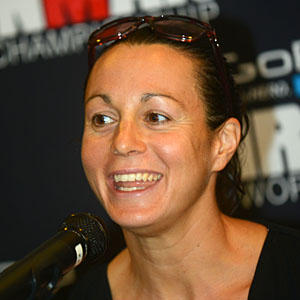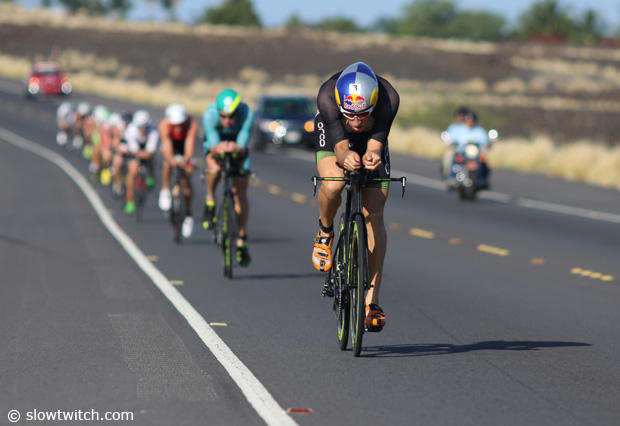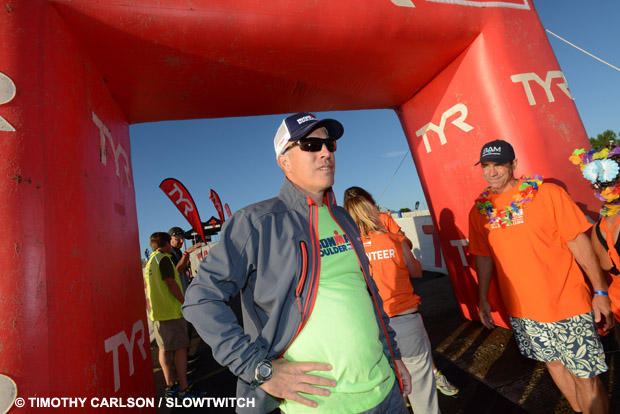TriEqual’s Rachel Joyce Talks

There's a push being made by the pro women and many of their supporters to raise the number of pro women qualifying for Kona from 35 to 50, equal to the slots for pro men. It's called TriEqual. Among the pro women spearheading this effort is talented, articulate British pro Rachel Joyce. She's been 2nd and 3rd at the last two Hawaiian Ironman World Championships, she's a winner of Challenge Roth, and she's a lawyer.
I'm sympathetic to the issue, but this isn't an ethical no-brainer. Reasonable people can see another side and I asked questions the other side might ask. Also, the space at Kona's is pier is finite. These women aren't just asking for more slots, they're asking for someone else's slots.
I asked Rachel about this, partly because it's newsworthy, partly because it's rare to find a pro triathlete willing to take, and work hard at, a political issue in triathlon. Is she the Erin Baker of her generation? Here's what she had to say.
SLOWTWITCH: Rachel, I'd like to ask you first about the concept of equality. There is equality in prize money and in access compared to, say, cycling, where there is nothing even close to equal access to opportunities like 21-day stage races. In triathlon, women have always had the ability to toe the starting lines of every race available to men, earn the same prize money, including in Kona. The issue in Kona is whether equal in the context of slots on the pier is equal numbers, or equal depth of field. Why are equal numbers more important than equal depth of field?
RACHEL JOYCE: You are right. In many respects triathlon is leading the way in terms of equality in sport although I would question the comparison to cycling, a sport with a long history of doping and corruption and inequality. I wrote about this a couple of years ago in Triathlete Europe and commented that I was proud to be part of such a forward thinking sport. However, just because we are better than some does not mean that we should rest on our laurels and be complacent. We [the founders of 50 Women to Kona] came together because we wanted to end the inequality for the women pros in Kona.
Fewer pro women than men are given to opportunity to race at two of the sport's biggest events: Kona and the World 70.3 Champs. What does this mean? Pro women do not have the same opportunity as the pro men to the benefits that come with racing in Kona in terms of sponsorship, experience and exposure.
Ironman is unique. Pros race with the age groupers and that creates a real sense of community. We saw that on International Woman's Day when pros, age groupers, supporters came out on social media to support #50womentokona. These people do not have a personal interest in supporting equality for the pro women. They support #50womentokona because they want their sport to be equal.
With regard to the counter argument that the women's field has less depth. First, I do not agree. Create the opportunity and the supposed depth will follow. We've seen that work at the ITU level and in other sports. However, an in-depth statistical analysis undertaken by Thorsten Radde indicates these arguments are in fact baseless. The number 35 was not decided on through any calculation. I suspect it is a number decided on as feeling about right to the powers that be at the WTC.
ST: Do you support a more equal distribution of slots among the age groups? Using the same reasoning?
RJ: In the age group fields, equality will happen once we see an increase in participation rates. The mechanism is in place to make this happen once we see the number of women taking part increase due to the proportional allocation of Kona slots. The question then becomes how do we increase participation amongst age group women. That is something we are going to look at and hope to promote through TriEqual. On the day of the launch we already had almost 200 people volunteer through the website saying they want to help promote the sport to girls and women. This response is very encouraging. We now need to harness that enthusiasm and manpower to look at what we can do to accelerate the growth of the sport amongst women.
ST: Mind, I didn't ask you about age-group women. I asked you about age groupers. You are arguing, for your cohort or pro women, "Create the opportunity and the supposed depth will follow." For age groupers you're saying equality happens once the participation increases. I don't mean to belabor this, it just sounds to me like you're treating your cohort differently than mine, and that's okay. I understand that our cohorts are not entirely analogous. I'm happy to hear any final thought on this you may want to add.
RJ: There is a mechanism in place which means Kona slots are distributed somewhat proportionally. I like that every age group has at least one spot notwithstanding there may only be one person racing in that age group. For example, once we see the number of women racing in Ironman races increase the numbers of women in Kona will increase due to how Kona slots are allocated.
This is not the same as the inequality we see with the professional women in Kona. Professional women are racing at the top of the sport. What other sport do you see statistical arguments about total numbers of professionals used to allocate fewer world champion and/or finals spots? Professional women are role models. Professional women should have equal opportunity to earn Kona "bonuses" for qualifying in Kona. Professional women should have equal opportunity to represent their sponsors on the world stage.
ST: It's my understanding that Andrew Messick, last year, gave the pro women already having qualified for Kona this option: If the majority voted for an increase from 35 to 50, he'd do it. What I heard was that fewer than 5 of those voting agreed to this. Now, to me it's somewhat cynical and manipulative to put it to the women this way: If Ironman thinks there ought to be 50 women it should just make the number 50. But the vote, if it went down this way, exposes a truth. Yes, the affected women have a point: they raced extra races, worked extra hard, got in shape earlier, to qualify for those 35 slots, so those extra 15 who would be ushered in would have had an easier qualification road. Still, the women could have taken one for the team. They could have sacrificed. Had they just voted to make this change, we'd be at 50 right now. The women want something, but they could have had it by now. They weren't willing to make any sacrifice for it. Why is the view I just espoused wrong-headed?
RJ: That is not what happened in August, 2014. I think it is important that Slowtwitch readers understand what was offered to the pro women. On the weekend of Ironman Boulder a group of pros – including men and women – met with representatives of the WTC. The offer on the table was 10 more slots for 2014. Whilst an improvement an offer of 10 more slots meant there would still be fewer qualifying starting slots for the professional women. The offer was conditional on:
A) A majority of the women making the first Kona qualification cut voting to accept the additional slots; and
B) Each of the Kona qualifiers donating one day of their time to the WTC free of charge to promote Ironman events to women.
Further, it was emphasized to the professional women voting that there was zero guarantee that the additional 10 slots would be available the following year.
I personally decided to vote in favor of the additional slots. I felt it would be very difficult to take away slots from the professional women once they had been given. I also thought it would easier to fight for 5 than for 15 extra slots in 2015. With that said, I also made it clear that I completely understood the NO vote. Why? Whilst the offer was made in good faith it did not address the equality issue for 2014 and it did not guarantee equality in future years. I cannot say that had these two things being guaranteed there would have been a YES vote but in the circumstances I think the vote should be understood in the proper context.

ST: Would you be as happy with 35/35 as you would with 55/55? Do you have a sense for what you think the right number should be?
RJ: My view – my view, not TriEqual's view – is that 55/55 is too many but ultimately I would like the WTC to make a decision on the exact numbers, provided of course those numbers are equal. I do not want equality for women to be seen as coming at a cost to the men. First let us achieve equality. Then the question of how many pros should be on the start line deserves its own discussion.
This question is tied up with other factors but equality is not one of those factors. Let's pretend they extended the pier and worries about how many bikes we can fit in the transition area stopped being a factor. Would 55/55 be the right number? I do not think so. The men had approximately 55 starters and we saw a high dropout rate. Why? When prize money only goes 10 deep why fight for every spot after that? Many people will, and do. Others have to think about earning a living. Do they tap out a marathon for 34th place or do they pull out and turn their focus to another Ironman post Kona where they will have an opportunity to earn prize money and bonuses?
Ironman is not cycling. You cannot spin it in to the end of the stage and be ready to fight the next day. You have to be smart and respect what an Ironman does to your body. So, maybe we do reduce the number of professionals racing in Kona. Maybe we also review how deep the pay goes.
Finally, you asked me why I want to see equality in professional racing so that is what I have answered. I want to say that Ironman is doing a huge amount of things right. The new qualifying system for professionals is a big improvement. The tracking device at championship races is a great addition. I think it is great that professionals are present and part of the IronKids series. I have yet to have a bad experience due to organizations at an Ironman; they are the best events to be a part of. I just think equality at the professional level should not be in debate.



